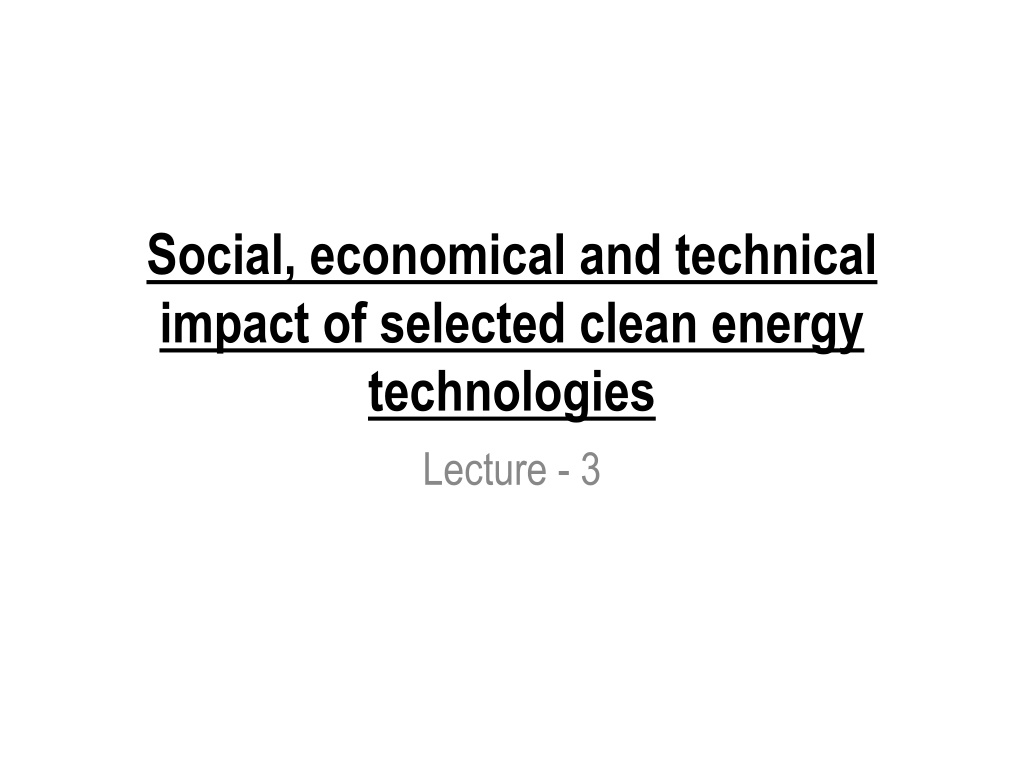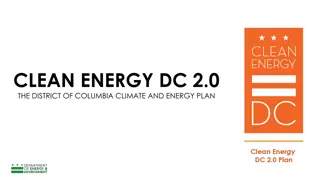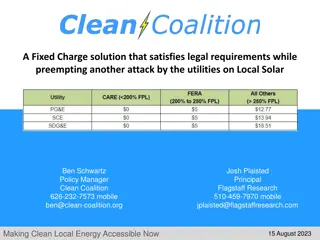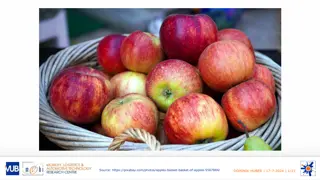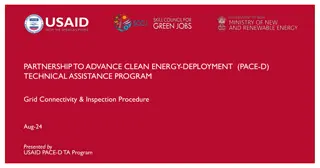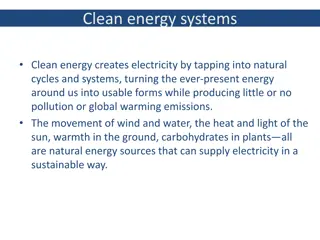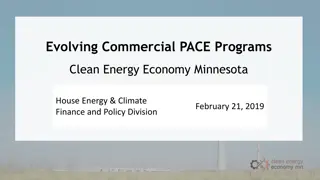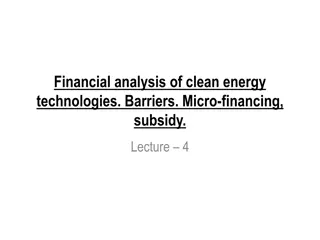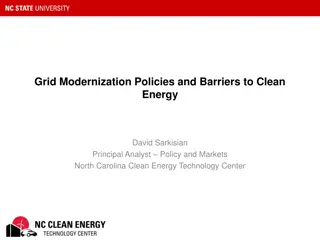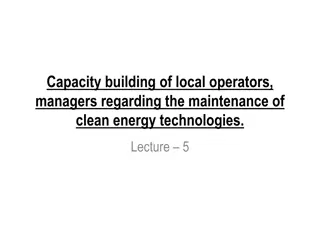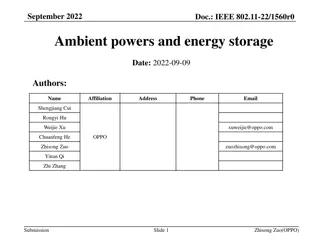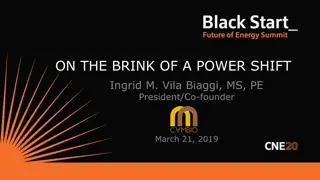Social, Economical, and Technical Impact of Clean Energy Technologies
This course covers the management of micro-level clean energy projects, emphasizing the social, economic, and technical impacts of selected clean energy technologies. It discusses project organization, tools, project life cycle, financial analysis, barriers, capacity building, and more. It delves into the social aspects of clean energy technologies, highlighting benefits such as improved health, consumer choice, self-reliance, work opportunities, and technological advances. Additionally, it explores the social impact of biomass projects, including improved health, consumer choice, self-reliance, work opportunities, and technological advances. The course also examines the economic impacts of biomass technologies, focusing on energy security, job creation, local market creation, affordable energy supply, waste management, and poverty alleviation. Furthermore, it touches on the transition of energy and environmental issues, covering energy sustainability, renewable energy, climate change, GHG reductions, air pollution, and emissions.
Download Presentation

Please find below an Image/Link to download the presentation.
The content on the website is provided AS IS for your information and personal use only. It may not be sold, licensed, or shared on other websites without obtaining consent from the author. Download presentation by click this link. If you encounter any issues during the download, it is possible that the publisher has removed the file from their server.
E N D
Presentation Transcript
Social, economical and technical impact of selected clean energy technologies Lecture - 3
OUTLINE OF COURSE MANAGEMENT OF MICRO LEVEL CLEAN ENERGY PROJECTS Introduction to project management for clean energy system at micro level. Functions of project based management: scope of work, project organization, quality, cost and duration Tools and techniques of project-based management Project life cycle. Processes of project management. Types of management Methods of selecting sustainable clean energy technologies for the household, community. Social, economical and technical impact of selected clean energy technologies Financial analysis of clean energy technologies. Barriers. Micro-financing, subsidy. Capacity building of local operators, managers regarding the maintenance of clean energy technologies. Project management of micro level clean energy projects (such as MHP, SHS, wind energy for electricity generation and irrigation, biomass gasifiers etc.).
Social aspects of CET Different social aspects: Disparity in income Disparity in raw material, energy resources and sources, standard of living, educational level, climatic conditions, Demography Difference between urban and rural sector Social benefits: Improved health Consumer choice Greater self-reliance Work opportunities Technological advances http://greenenv.blog.com/files/2009/06/akella_2009_renewable-energy.pdf 3
Social impact of biomass projects Improved health (reduced mortality and disease due to indoor smoke) Consumer choice (the range of competing products and services from which a consumer can choose) Greater self-reliance (energy security) Work opportunities (time saved for wood collection) Technological advances (access to modern energy services) Food security Household income (change in income) 4
Economical impacts of biomass technologies Energy security Employment generation (job creation) Creation of local markets Affordable energy supply Waste management energy from waste (reduction of waste disposal) Poverty alleviation 5
The transition of energy and environmental issues Energy sustainability Renewable Energy Climate Change GHG, CO reductions Air Pollution Emissions: VOC, NOx, CO, PM 6
Environmental aspects Environmental pollution (air, water) due to increased energy consumption Air pollution: Air pollution is one of the aspects of the environmental problems. The following pollution agents are sulphur dioxide, nitrogen oxides, ozone, dust and aero-sols, carbon dioxide, chlorofluorocarbons, steam-laden emissions and meteorological inversion. Water pollution: The following environmental benefits are: 7 http://greenenv.blog.com/files/2009/06/akella_2009_renewable-energy.pdf
Environmental aspects Environmental pollution (air, water) due to increased energy consumption Air pollution: Water pollution: Water pollution occurs primarily from: (i) effluents such as water discharges from households, industries, trade or polluted rain, (ii) discharge of used oils, (iii) discharge of liquid substances containing poisonous chemicals including heavy metals (mercury, lead, etc.), also products like arsenic, zinc, copper nickel, cadmium, etc., and (iv) pollution by acid rain precipitation. The following environmental benefits are: 8 http://greenenv.blog.com/files/2009/06/akella_2009_renewable-energy.pdf
Environmental aspects Environmental pollution (air, water) due to increased energy consumption Air pollution: Water pollution:. The following environmental benefits are: (i) reduced air pollution, (ii) lower greenhouse gas emissions, (iii) lower impacts on watersheds, (iv) reduced transportation of energy resource and (v) maintaining natural resources for the long term 9 http://greenenv.blog.com/files/2009/06/akella_2009_renewable-energy.pdf
Impact Impact is understood to mean both positive and negative change produced directly or indirectly, intentionally or unintentionally, by a development intervention. This includes the main impacts and effects resulting locally from the activity in terms of social, economic, environmental and other development indicators. 10
Sustainability of RE projects Sustainability of a project, i.e. access to clean energy services, business, employment and training opportunities, food security etc., are likely to persist after donor funding has been with drawn. Sustainability can be assessed by answering the following two questions: 1) to what extent did the benefits of a project continue after donor funding ceased? And 2) what were the major factors which influenced the achieve mentor non-achievement of sustainability of the project? 11
Social and economic impacts of solar PV. Impacts Land use and landscape Positive Decreased land use compared to conventional energy resources Reuse of degraded sites Use of unused sites (such as in deserts) Multi-purpose and integrated use on existing developments or buildings (like rooftops, facades) Negative Unavailable land/high competition with other land uses (such as agriculture) Degradation of vegetation and soil erosion Higher up-front costs Visual/landscape experience Microclimatic change Glare risk by reflection Requirement for energy storage for continuous supply Infrastructure Reduced transmission lines/ grids Energy supply for decentralized, low-density off-grid areas, also in developing countries 12
Social and economic impacts of solar PV. Impacts Political Positive National energy independency from import Lower military expenses (less conflicts in the oil rich countries) Diversification Deregulation Job creation Higher development and education level Increased environmental consciousness Improved image Negative Economically detrimental subsidies such as uncontrolled and miscalculated fee-in-tariff mechanisms Energy market Industry, R&D, education Public & marketing Intermittent supply issues Health hazards and risks during manufacturing phase None 13
Social and economic impacts of biogas. Impacts Positive Negative Replacement of fuel wood, agricultural residues and cattle dung Reduces use of chemical fertilizer Saving of fuelwood Deforestation, soil erosion, landslides are minimized Collection of cattle dung and water as a feeding material for the plant Owning of cattle is costly Farm distance from the biogas plant Bio-slurry is a good fertilizer which will not destroy the quality of soil Available time can be used for the contribution to household income Biogas is advance technology in comparison to traditional cooking options. Time saving and work load reduction Financial support or saving is required to initiate the business Technology Trained manpower is required for construction, operation and maintenance of plant Gas leakage Initial investment is high Poor can t afford Cost Govt. has subsidy program to install the program 14
Social and economic impacts of biogas. Impacts Positive Negative Gender benefits and cost Work burden of female and girls is reduced. Cooking time and cleaning utensil time reduced and no firewood collection Male members are interested in cooking Indoor air pollution is significantly reduced It reduces eye illness, headache, cough associated with smoke from fuel wood and dung cake using traditional three fire stoves Better cattle dung management Even female children can attend the school. They can do homework in light. Biogas generation is a function of temperature. So, in cold weather the production rate is low Biogas stove is costly. Health hazards in handling & transporting slurry Health and sanitation Education Change in parent s attitude to send female child to school is needed. Only trained one will have better job opportunity. Job opportunity During construction time farmers are employed. Some of them are employed for maintenance works. 15
Social and economic impacts of wind farming Impacts Positive Negative Job creation Job creation during construction and during operation and maintenance Only trained one will have better job opportunity. Fiscal impacts Land lease will provide benefit to individual Tourism and recreation Rural views are destroyed Recreation area will be affected by noise of wind turbine and moving shadows wind turbines would disturb the pristine natural setting. Quality of life Proponents of wind energy may experience an increase in quality of life once a wind farm is built. Leasing land to the proximate of wind farm will have economic benefit Land can be used for farming as well as for grazing . Social cohesion Biodiversity No economic benefit if land is far from wind farm. Birds, bats are killed by wind turbine 16
Social and economic impacts of MHP Impacts Positive Negative Land and water use Power is generated from flowing rivers Water coming from powerhouse can be used for irrigation Depending on the rate of water flow maximum electricity is generated Water flow can be maintained in plain areas for cultivation if the power house is located at higher altitude than the agricultural field. Safe access to power house, forebay, intake etc Water right has to be considered. Land for pipe layout, powerhouse, access path, transmission line Water flow and quality Decreased water quality cause water borne diseases Ecosystems Population growth in MHP area will generate pressure on natural resources and the risk of erosion in areas close to the powerhouse is increased Maintenance difficult if the access path is not appropriate and damaged Safety 17
https://www.academia.edu/1911225/Socio-economic_impacts_of_a_micro-https://www.academia.edu/1911225/Socio-economic_impacts_of_a_micro- hydropower_plant_on_rural_livelihoods 18
Social and economic impacts of MHP Impacts Positive Negative Job creation Job for locals during construction, operation and maintenance of MHP Increased access to market area and increase income from tourism As a support govt subsidy is available for the MHP project Saving primary energy sources (coal, oil, natural gas, etc..), Reduction of related activities (production, transmission and distribution, reducing demands on waste). Only the trained one will get an opportunity. Cost Subsidy dependency is practiced, not sustainable Related to the actual implementation of the various structures Land grab, Impact on ecosystems and biodiversity, The significance of these Impact on the landscape. impacts will mainly depend on their position with regard to environmentally significant areas Replacement of fossil fuel 19
MHP in Nepal Positive impacts of MHP Issues and challenges of MHP It has a positive impact on income from livestock and small business but has no evidence of impact on farm income. It has both direct and indirect health benefits. It has a positive impact on the educational outcomes It has played a vital role in improving access to information. It has a positive impact on women s involvement in household decision making process. Very poor and remote communities left. Difficult to raise awareness and motivation. Difficult to find even unskilled labors in the villages gone for remittance. Waiting for others to come work for them. Various conflicts in community. The leaders of the user group made MHP enterprises for income. Those who are financially better are adopting PV End use applications established has increased business activity, created employment opportunities and improved livelihood in general. Mini grid electrification has a positive impact on the environment. Mini grid has met household s expectation. Reduce people s aggression with government. Up scaling and upgrading scaling up the implementation, upgrading quality of technology and construction. Inter connection and grid connection of existing schemes. Capacity addition in old projects due more demand Financial viability in business model Operation and management of plant in local level Fate of the micro hydro plant after grid expansion Rehabilitation and protection from natural calamities 20
Carbon trading. CDM A carbon trade is an exchange of credits between nations designed to reduce emissions of carbon dioxide. The carbon trade allows countries that have higher carbon emissions to purchase the right to release more carbon dioxide into the atmosphere from countries that have lower carbon emissions. The carbon trade originated with the 1997 Kyoto Protocol and is intended to reduce overall carbon dioxide emissions to 5% below 1990 levels between 2008 and 2012. The Kyoto Protocol separates countries into two groups. Annex I includes developed nations, while Non-Annex I refers to developing countries. Emission limitations are only placed on Annex I countries. Non-Annex I nations participate by investing in projects that lower emissions in their own countries. For these projects, they earn carbon credits. These credits can be traded or sold to Annex I countries, which allow them a higher level of maximum carbon emissions for that period. 21
Kyoto Protocol Kyoto Protocol was adopted at the 3rd session of the Conference of the Parties to the United Nations Framework Conference on Climate Change held in Kyoto, Japan in December 1997. The Protocol defines the quantified GHG emissions reductions for Annex I Parties. Kyoto Protocol introduces 3 market mechanisms (Kyoto Mechanisms) Annex I Parties would be able to achieve their emission reduction targets cost-effectively by using these mechanisms. Joint Implementation (JI) Clean Development Mechanism (CDM) International Emission Trading (IET)
Clean Development Mechanism (CDM) The Clean Development Mechanism (CDM), defined in Article 12 of the Protocol, allows a country with an emission-reduction or emission- limitation commitment under the Kyoto Protocol (Annex B Party) to implement an emission- reduction project in developing countries. Such projects can earn saleable certified emission reduction (CER) credits, each equivalent to one tonne of CO2, which can be counted towards meeting Kyoto targets. http://unfccc.int/kyoto_protocol/mechanisms/clean_development_mechanism/items/2718.php 23
Key goals of CDM To assist developing countries who host CDM projects to achieve sustainable development; To provide developed countries with flexibility for achieving their emission reduction targets, by allowing them to take credits from emission reducing projects undertaken in developing countries.
Credit Emission Reductions (CER) CDM is source of income for developing countries by carbon trading. CDM project will be measured in standard units known as Certified Emission Reduction (CERs). These are expressed in tons of CO2 emission avoided. For example: 5 CERs means 5 tons of CO2 is reduced.
http://cdm.unfccc.int/Statistics/Public/CDMinsights/index.html 28
GHG emission from various energy sources GHG emissions SO2, g/kWh 11.8 1.5 14.2 - 1.6 0.03 0.009-0.024 0.02-0.09 0.2-0.34 0.13-0.27 0.07-0.08 (0.06-0.08) 0.02 Energy sources CO2, g/kWh 955 987 818 NOx, g/kWh 4.3 2.9 4.0 0.5 12.3 0.07 0.003-0.006 0.02-0.06 0.18-0.30 0.06-0.13 1.1-2.5 (0.35-0.51) 0.28 Coal (best practice) Coal (NOx) and FGD (flue gas desulfurization) Oil (best practice) Natural gas (CCGT-combined cycle gas turbine) 430 Diesel Small hydro Large hydro Wind Solar photovoltaic Solar thermal electric Energy crops current practice Energy crops (likely to improve to) Geothermal 772 9 3.6-11.6 7-9 98-167 26-38 17-27 (15-18) 7-9 29
References http://greenenv.blog.com/files/2009/06/akella_2009_ren ewable-energy.pdf http://www.seedengr.com/Socio- economic%20benefits%20of%20Renewable%20Energ y.pdf http://www.climateinvestmentfunds.org/cif/sites/climatei nvestmentfunds.org/files/Social%20Impacts.pdf https://www.researchgate.net/publication/222544240_S ocial_Economical_and_Environmental_Impacts_of_Re newable_Energy_Systems https://cdm.unfccc.int/ 30
Tasks Impacts Solar PV Wind farm MHP Biomass gasifier Air pollution Environmental Noise Water pollution Biodiversity Stakeholders Social Participation Energy security Reduced external effects Economical Macro-economic benefits Local economic activity 31
Assignment Choose an appropriate technology (working, capacity and size, pros and cons etc) and discuss the social, economical and environmental impact and challenges of chosen technology for the following projects. Roll no. Topics Roll no. Topics 072/MSES/451 SHS for lighting 072/MSES/459 Wind electricity for electricity 072/MSES/452 SHS for computer education in school 072/MSES/460 MHP for electricity and small business 072/MSES/453 SHS for health post 072/MSES/461 Wind pump for irrigation 072/MSES/454 SHS for cyber caf 072/MSES/462 Biogas for cooking 072/MSES/455 Solar water pump for drinking water 072/MSES/463 Bio-briquette for cooking and space heating 072/MSES/456 Solar water pump for drip irrigation 072/MSES/464 Mud ICS for cooking 072/MSES/457 Solar water heater for lodges home stay 072/MSES/465 Metallic ICS for cooking and space heating 072/MSES/458 Solar dryer for fruit/ vegetable preservation 072/MSES/466 Solar cooker for preparing day meal Submission date: July 10, 2016 (Sunday) 32
